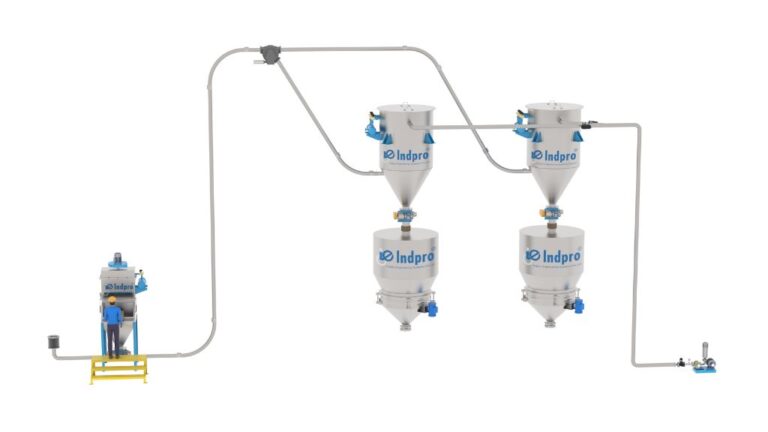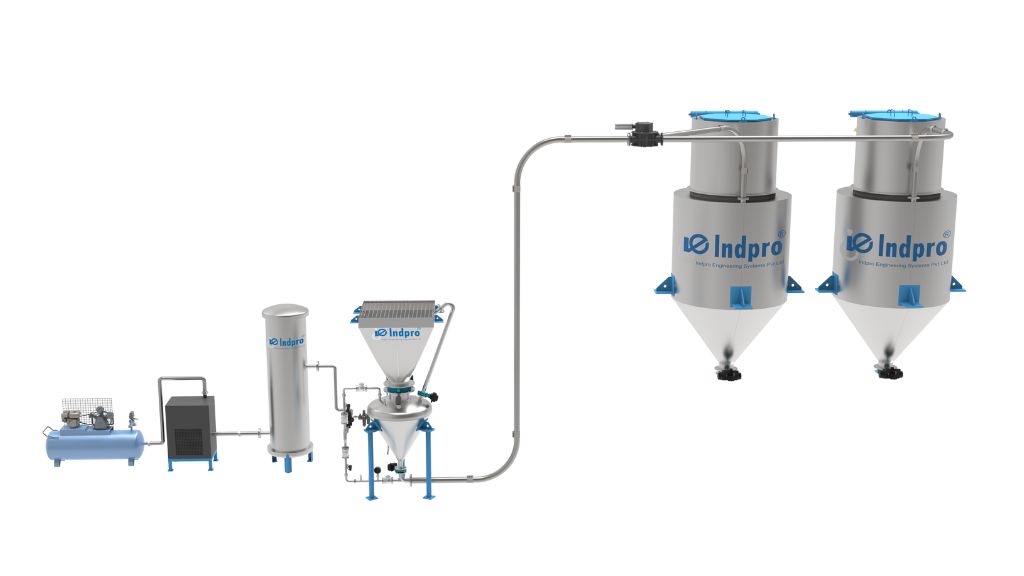Dilute phase vs dense phase conveying
Dilute phase vs
dense phase conveying
When one decides to automate their bulk material handling using a pneumatic conveying system, the question that arises is whether to go for a dilute phase vs dense phase system. Different people have different opinions on why one technology is better than the other, but it is important to know the facts which will help you in deciding which is best suited for your application.
Dilute phase pneumatic conveying is a method of transporting bulk materials through a pipeline using a stream of high velocity but low-pressure air. The high velocity of air suspends the bulk material in the air, by virtue of which, the material is then transported at high velocities.

Advantages of Dilute Phase Pneumatic Conveying
- High conveying speeds.
- Low capital cost.
- Easy to install, operate and maintain.
- Can handle a wide range of materials.
- Compact and space saving.
Disadvantages of Dilute Phase Pneumatic Conveying
- Material degradation due to high velocities.
- Material separation during transport.
- High energy consumption.
Dense phase pneumatic conveying is a method of transporting bulk materials through a pipeline using a stream of low velocity but high-pressure air. The high-pressure of air aids in formation of plugs or dunes of the bulk material in piping, by virtue of which, and the material is transported at low velocities.

Advantages of Dense Phase Pneumatic Conveying
- Low material degradation.
- Reduced material separation.
- Lower energy consumption.
- Can handle long distances.
Disadvantages of Dense Phase Pneumatic Conveying
- High capital cost.
- Difficult to install, operate and maintain.
- Limited range of materials.
- Equipment is space consuming.
Comparison of Dilute Phase and Dense Phase Pneumatic Conveying
The key differences between dilute phase and dense phase pneumatic conveying include:
- Material compatibility: Dilute phase pneumatic conveying systems are better suited for materials that can withstand high velocities and are not easily degraded, while dense phase systems are better suited for materials that are fragile and may get damaged during handling.
- Air pressure: Dilute phase systems operate at lower pressures, typically between 0.1 and 1 bar(g), while dense phase systems operate at higher pressures, between 1 and 6 bar(g).
- Conveying distance: Dense phase pneumatic conveying systems can handle longer distances, while dilute phase systems are better suited for shorter distances.
- Energy consumption: Depending on the application, dilute phase systems may consume more energy than dense phase systems due to their high velocity conveying.
- Maintenance: Dense phase systems require higher maintenance than dilute phase systems due to additional moving parts and more complex operation philosophy.
Applications of Pneumatic Conveying
Pneumatic conveying systems are used in a wide variety of industries, including:
- Plastics and Polymers
- Food and Spices processing
- Pharmaceuticals
- Chemical manufacturing
- Minerals
- Mining
- Recycling
Selection of a Pneumatic Conveying System
When selecting a pneumatic conveying system, there are several important factors to consider, including:
- Material to be conveyed and the necessary physical and chemical properties.
- Distance to be transported, along with the routing.
- Throughput of conveying required.
- Specific operating conditions that may be encountered during the process.
By carefully evaluating these factors, it is possible to select the right system for the job to ensure that materials are transported safely and efficiently.
System Maintenance
The maintenance requirements of pneumatic conveying systems depend on the type of system used. Different parts of each system have specific considerations for calculating the maintenance cost of the system. For certain materials, dilute phase pneumatic conveying systems require more maintenance due to the high velocity conveying, which can cause wear and tear of certain equipment. Maintenance tasks for dilute phase systems may include cleaning, replacement of piping components, replacement of wear components, and monitoring of air pressure and flow rates. Maintenance tasks for dense phase systems may include periodic cleaning, replacement of valves, inspection of piping, replacement of wear components, inspection of electrical components, and monitoring of air pressure and flow rates.



